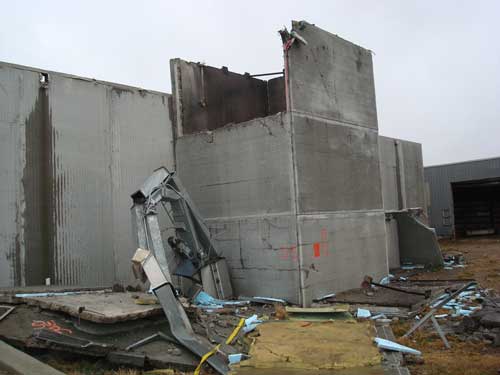"Do not use water or traditional fire fighting foam; however, micelle
encapsulator fire extinguishing agent, such as F-500, should be used.
NFPA 1620, Standard for Pre-Incident Planning can be used to establish a
pre-incident plan for silos within their jurisdiction so as to minimize
the risk to emergency responders" NIOSH Accident Report
 |
| Coal storage silo after explosion (NIOSH photo) |
Excellent job NIOSH sharing this educational accident report with the public providing valuable seven recommendations This will assist immensely in minimizing the severity of future combustible dust related accidents. CDPI encourages additional items in future recommendations regarding fire service emergency response to combustible dust related incidents throughout the manufacturing and non-manufacturing sectors:
Item #1: Fire departments should review, revise and enforce standard operating guidelines (SOGs) for structural fire fighting addressing responding to all combustible dust related incidents.
Item #2 Fire departments should train officers and fire fighters on the hazards associated with different types of processes handling and processing combustible particulate solids (CPS) and the appropriate fire fighting tactics.
Item #3: Fire departments should ensure that pre-emergency planning is completed for all processes handling and processing combustible particulate solids (CPS) within fire department jurisdictions. For example, a topic not yet addressed in NFPA 1620 Chapter 8.4, Special Hazard Considerations –combustible dust.
Item #4: Fire departments should ensure that a separate Incident Safety Officer, independent from the Incident Commander, is appointed at each structure fire and is knowledgeable of combustible dust related fire and explosion hazards.
Item #5: Municipalities should consider requiring that placards with hazard warnings and appropriate fire fighting guidelines be placed on buildings, bulk storage enclosures, air material separators, or other process equipment where the is a danger of a combustible dust deflagrations. Example: Hazard Warning Sign - Danger Explosive atmosphere
It is essential the fire service be acknowledged as a valuable and essential stakeholder in addressing combustible dust related fire and explosion workplace hazards. NIOSH and OSHA must work in a collaborative nature which must welcome the inclusion of the US Fire Administration.
On the other side of the coin the NIOSH accident report missed the boat when not including all high risk occupancies that handle, manufacture, process, combustible particulate solids. Solely limiting the recommendations to silos ignores the big picture of combustible dust related fire and explosion hazards the fire service is exposed to on a daily basis.
For example, over 70% of the recommendations in this recent NIOSH report were copied and pasted from an earlier accident report " Volunteer Assistant Fire Chief Dies at a 2010 Silo Fire/Explosion - New York" It is this type of future NIOSH recommendation that will finally include the fire service as a vital stakeholder in the current OSHA combustible dust rulemaking process. Do we have to wait for another firefighter fatality to finally get it right?
Examples of prior combustible dust related incidents with firefighter injuries:
Firefighter suffers second-degree burns battling blaze at facility in Monroe, OH (May 2012) "While attempting to extinguish the fire, Fire Chief John Centers said “there was a dust explosion” that caused the three injuries.""
Three firefighters injured after fire at Lumber mill in Gaston August 2011 "Firefighters were mopping up a fire that started in a powerhouse at the Lumber mill when a pipe exploded on a walkway, injuring them. "
BURNSVILLE, Minn. Explosion at Black Dog powerplant injures firefighters (August 2010)
"An Xcel spokesperson says the incident started as a smoldering fire in a coal hopper Firefighters were called, and were working the blaze when the explosion occurred around
Surgoinsville,TN firefighter injured in blast a Phipps Bend plant in TN (August 2009) (recycling newspaper to process oil absorbent pads) "a five-year veteran of the department, was standing near a storage bin where firefighters were cleaning up after attempting to extinguish burning fibers which had been ignited by sparks from a grinder, when an unexpected explosion occurred, according to Fire Chief Murlice Carpenter."
Six Stockton, California firefighters slightly hurt in plant explosion (Sept. 2008) "Five firefighters were just inside the building and one just outside the building on stairs when the explosion occurred. The firefighter on the stairs was the firefighter who suffered the worst of the injuries."
Pella, Iowa (Nov 2005) Two firefighters are recovering today after two explosions company "As firefighters tried to put out the fire, another explosion took place. "
Resources:
NIOSH Fatality Accident Report-fire in coal storage silo
NIOSH Fire Fighter Fatality Investigation and Prevention Program
Presentation by Tim Merinar & Tom Hales (NIOSH/DSR) entitled "NIOSH Fire Fighter Fatality Investigation and Prevention" at public stakeholder meeting;










 RSS Feed Subscribe
RSS Feed Subscribe
No comments:
Post a Comment